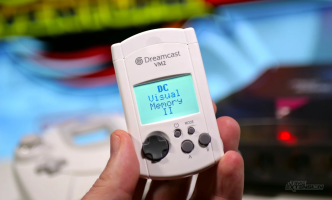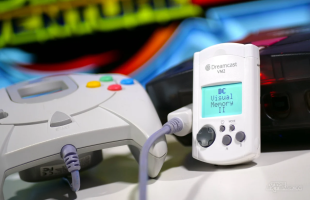General Information
While Sony had popularised the idea of a portable means of saving game data with its PlayStation console (and would come up with its own VMU-style device in the shape of the PocketStation), Sega's approach sought to bridge the gap between a memory card and a fully-fledged handheld gaming system, offering players the ability to indulge in mini-games while they were away from their main system. Furthermore, when connected to the console, the VMU offered each player their own "personal" screen, on which unique information could be displayed.
However, even for the most committed Dreamcast owner, the VMU would become a rather more annoying proposition over time due to its insatiable need for CR2032 batteries to function away from the host console. These batteries don't last as long as you think, leading to the now-infamous "beep" sound a battery-drained VMU emits when you turn on the Dreamcast.
Another irksome feature is that the VMU doesn't actually offer all that much storage space, especially when you consider that it was more expensive than PS1 or N64 memory cards. This necessitated the need to purchase more than one VMU if you had a large collection of games and saw a rise in third-party (and often unreliable) alternatives, which ditched the LCD screen but boosted the storage capacity four times over.
It's amazing that it has taken this long for a solution to the VMU's shortcomings to appear, but Greek company Dreamware (also known as DreamMods) has done just that with the Dreamcast VM2. Successfully crowdfunded in 2022, the VM2 is described as a "next generation" VMU that offers a wide range of upgrades over Sega's original model. In terms of design and build quality, it's genuinely difficult to tell this apart from the real deal. The plastic is high-quality, and the buttons and D-pad are decent, too – if a little small (the same complaint can be levelled at Sega's VMU, too).
The most obvious enhancement is the inclusion of a higher-resolution backlit LCD display, which means you can finally see what's being shown on the VMU when you're gaming in a dimly lit room. The catch is that Dreamware wasn't able to source a screen that's exactly the same as the one seen in the original VMU, so what we have here is a display that's the same width, but not quite as tall. Because it's a much higher resolution, though, this isn't noticeable; in fact, it's so high-res that, if you set the scaling to x1, the information is almost too small to read. The default x2 scaling makes it look very much like a standard VMU screen, although it does have some small gaps around the image.
The other big plus point is that the VM2 has an internal rechargeable battery, which can be topped up either via the USB-C port on the bottom or when it's connected to the Dreamcast's controller. A full charge is possible in around 15 minutes, and the unit will last about two weeks when left idle. If you play a lot of mini-games or keep the screen on for prolonged periods, you can expect that total to drop dramatically – but to be honest, unless you're planning on only playing mini-games and never connecting the VM2 to your main console, then you won't need to worry too much about its stamina (you can also disable the backlight if you want to eke out more playtime).
Finally, we have the other big selling point – the ability to create multiple "virtual" VMUs using MicroSD storage. The VM2 acts like a standard VMU out of the box, and comes with the typical 200 blocks of storage for either save data or mini-games. However, by inserting a MicroSD card (32GB is the maximum capacity), you can create virtual VMUs which can be cycled through by tapping the function button (found on the bottom of the VM2) during use.
These virtual VMUs can be created (and deleted) on the device itself, and by connecting the VM2 to your computer, you can archive them or use them in emulators. It's also possible to transfer your existing save data from an old VMU to the VM2; the Dreamcast treats virtual VMUs in exactly the same way it would treat a normal VMU.
It doesn't stop there, however; the VM2 has a host of other cool things that make it stand out. For example, if you have a GDEMU ODE installed running the latest version of openMenu, it's possible to have the VM2 automatically switch between virtual VMUs when booting a game, without having to toggle between them manually. Also, homebrew VMU games can be loaded up on the VM2 using the USB-C connection; Tiny Tetris comes highly recommended.
You can also boost the internal clock speed to make VMU mini-games run faster, change the VM2's region and even enable a "ghost" mode which replicates the ghosting seen on the original VMU's LCD screen. You can also simulate the aforementioned "dead battery beep" if you're (for some inexplicable reason) missing it.
The VM2 goes to sleep when left untouched for a few minutes, but can be forced into sleep by holding the Mode button for three seconds when on the main Home screen. Once asleep, pressing A or B will wake it from its slumber, which is pretty much instantaneous. To fully turn off the device – which you may wish to do if you're carrying it around in your pocket and want to avoid an accidental switch-on – you have to hold down the power button for ten seconds.
We found that the MicroSD card slot on our unit was rather poorly cut out, and the plastic cap which clips onto the top of the VM2 is rather hard to remove. We also noticed that when used with the Retro Fighters StrikerDC controller, the VM2's MicroSD card slot would get snagged on one of the internal guide rails – not Dreamware's fault as such, but something to note if you happen to own that pad (we didn't encounter any issues with the stock Dreamcast controller in this regard, and the wireless variant of the StrikerDC pad's memory card dock also worked without any issue).
The biggest hurdle for many people when it comes to the VM2 will be the price. At €120 / $132 / £100, this is not a cheap purchase – but then again, it's worth noting that it has essentially been made by a single person, who has also handled the software and firmware side of things, too. Securing the parts needed to build each unit won't have been cheap for such a small operation, and without mass-market production to bring the cost down, it's inevitable that you're going to pay a little over the odds for a project like this.
We'd hazard to guess that anyone who still plays their Dreamcast in 2024 will be dedicated enough to feel that the price tag is more than justified, however – it solves so many of the VMU's more egregious problems, making it feel like a truly modern product. The other big downside is that the VM2 is almost always in high demand, and currently, Dreamware has closed pre-orders while it catches up with demand.
There's no denying that the VM2 is must-have device for every self-respecting Dreamcast owner, provided you can get your hands on one – but if you find the cost to be a little on the steep side, then it's worth noting that a rival product is on the horizon (although there's no guarantee that won't be expensive, too).




